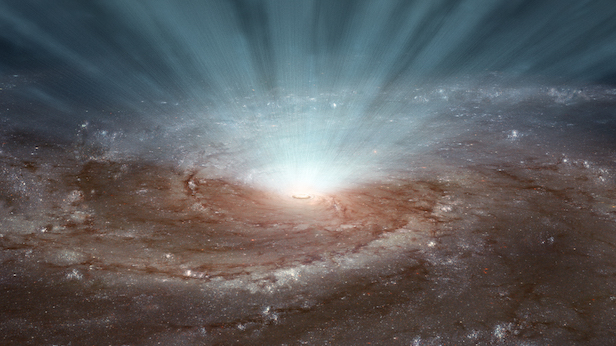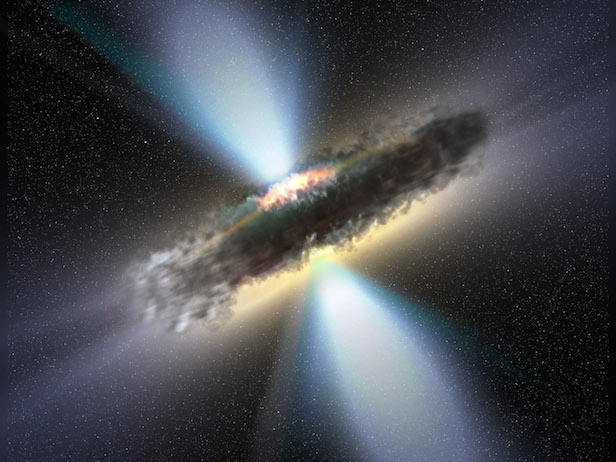Super black holes in massive galaxies control star formation
A recent study has revealed a link between the mass of a galaxy’s supermassive black hole and its stellar history

The energy pouring out of the black holes at the centre of massive galaxies are hindering star formation in surrounding regions. Image credit: NASA/JPL-Caltech
Young galaxies are known for creating numerous stars at a rapid rate, which gives off copious amounts of energy. However, as the galaxy evolves, star formation eventually ceases. A team at the University of California Santa Cruz (UCSC), United States, has now stated that the mass of the supermassive black hole at the centre of the galaxy determines how soon the star formation stops inside these galactic structures.
To each massive galaxy is a supermassive black hole residing at its core, and they tend to be over a million times more massive than our own Sun. The enormous mass of this object means that not even light can escape its gravity, hence the term ‘black hole’. Although we cannot see the object directly, we can observe the effects on its surroundings, such as the galaxy’s own stars and sometimes the powerful energy released by its active galactic nucleus (AGN). It is thought that the energy that is emitted from the AGN is what heats up the surrounding gas, making it unable to condense into stars, also known as quenching.
This theory has been around for decades, and astrophysicists have found from simulations that galaxy evolution must take into account feedback from the black hole to properly reproduce the observed properties of galaxies. However, there has always been a missing link between observational evidence of supermassive black holes and star formation. That is until the team at USCS came along.
“We’ve been dialling in the feedback to make the simulations work out, without really knowing how it happens,” says Jean Brodie, professor of astronomy and astrophysics at UC Santa Cruz. “This is the first direct observational evidence where we can see the effect of the black hole on the star formation history of the galaxy.”
This new study has shown that there is a continuous interplay between black hole activity and star formation throughout the galaxy’s life. This interplay affects all generations of stars that have formed as the structure evolves. The study focused primarily on massive galaxies that have had their supermassive black holes mass measured in previous studies. To determine the star formation history, the USCS team analysed spectroscopic data of the galaxies’ light, gathered by the Hobby-Eberly Telescope Massive Galaxy Survey.
By separating the light of galaxies into their constituent wavelengths, a postdoctoral researcher at USCS, Ignacio Martín-Navarro, used computational techniques to determine each galaxy’s star formation history it’s spectra. By matching the best combination of stellar populations to fit the spectroscopic data, the evolutionary state of the galaxy can be deduced.

Supermassive black holes are thought to be surrounded by a thick ring of material known as a ‘torus’. Image credit: ESA/V. Beckmann (NASA-GSFC)
When Martín-Navarro compared the star formation history with the black holes of different masses, there were some striking differences. Noticeably, the variations only correlate with black hole masses, but not any other properties such as morphology, size, or others.
“For galaxies with the same mass of stars but different black hole mass in the centre, those galaxies with bigger black holes were quenched earlier and faster than those with smaller black holes,” says Martín-Navarro. “So star formation lasted longer in those galaxies with smaller central black holes.”
There has been unsuccessful work into correlations between star formation and the luminosity of AGNs, and Martín-Navarro suggests this may be due to the time-scales being so different. As star formation occurs over hundreds of millions of years, and AGN experiencing outbursts of a much shorter time period, these are noticeable time differences.
A supermassive black hole is only luminous when it is eating surrounding matter. Whereas, AGNs are highly variable and their properties rely on the size of the black hole, the rate of accretion of material among many other factors.
“We used black hole mass as a proxy for the energy put into the galaxy by the AGN, because accretion onto more massive black holes leads to more energetic feedback from active galactic nuclei, which would quench star formation faster,” explains Martín-Navarro.
What exactly is causing this feedback from the black hole that quenches star formation remains unclear. “There are different ways a black hole can put energy out into the galaxy, and theorists have all kinds of ideas about how quenching happens, but there’s more work to be done to fit these new observations into the models,” says Aaron Romanowsky, an astronomer at San Jose State University and UC Observatories.
Keep up to date with the latest reviews in All About Space – available every month for just £4.99. Alternatively you can subscribe here for a fraction of the price!




